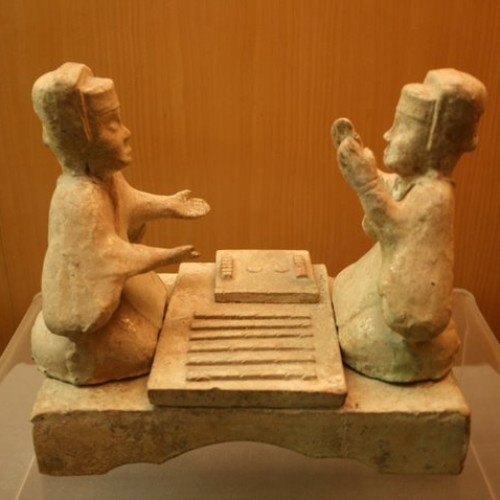LIUBO VS SÁHKKU

LIUBO
Liubo (Chinese: 六博 or 陸博; pinyin: liù bó; Wade–Giles: liu po; lit. 'six sticks') is an ancient Chinese board game played by two players. For the rules, it is believed that each player had six game pieces that were moved around the points of a square game board that had a distinctive, symmetrical pattern. Moves were determined by the throw of six sticks, which performed the same function as dice in other race games. The game was invented no later than the middle of the 1st millennium BCE, and was popular during the Han dynasty (202 BCE – 220 CE). However, after the Han Dynasty it rapidly declined in popularity, possibly due to the rise in popularity of the game of Go, and it became totally forgotten. Knowledge of the game has increased in recent years with archeological discoveries of Liubo game boards and game equipment in ancient tombs, as well as discoveries of Han dynasty picture stones and picture bricks depicting Liubo players. It is not known when the game of Liubo originated, although according to legend it was invented by Wu Cao (烏曹, called Wu Zhou 烏胄 in the early 2nd century CE Shuowen Jiezi dictionary), a minister to King Jie, the last king of the Xia dynasty, who according to traditional chronology reigned 1728–1675 BCE. While there is no archeological or reliable documentary evidence to support the view that Liubo dates back to the Shang dynasty (1600–1046 BCE), early Chinese records do indicate that Liubo was already a popular game by the Warring States period (476–221 BCE). For example, the Records of the Grand Historian records a speech made during the reign of King Xuan of Qi (reigned 319–301 BCE) that claims that the capital city of Linzi was so wealthy that its citizens were all able to indulge in activities such as playing musical instruments, cockfighting, dog racing, playing Liubo and playing kick ball.
Statistics for this Xoptio

SÁHKKU
Sáhkku is a board game of the Sami people. The game is traditional among the North Sámi, Skolt Sámi, Inari Sámi and Lule Sámi but may also have been played in other parts of Sápmi. Sáhkku is a running-fight game, which means that players move their pieces along a track with the goal of eliminating the other players' pieces. Many different variants of sáhkku have been played in different parts of Sápmi. The oral transfer of the sáhkku rules between generations was largely broken off during the 1900s (see Sáhkku today). A few of the local variants have survived into our time, other local variants have been reconstructed based on a combination of memories and written sources, and for some places only fragments of the local rules are known from old documents. A sáhkku board (sáhkkufiellu, bircunfiellu or sáhkkulávdi) can traditionally be designed in a number of different ways. At its simplest, a sáhkku board has three parallel rows of short lines, and the pieces are placed on these lines. The lines are called sárgat (one sárggis) in Sámi. It is common to draw the short lines as vertically connected to each other, so that the board appears to consist of just one row of very long lines, but the game is still played as if these were three separate rows of short lines. Such boards often also have three horizontal lines intersecting the vertical lines in order to illustrate that the lines are still in practice divided into three parallel rows. Some boards feature only a central horizontal line crossing the connected vertical lines, but the game is still played as if there were three rows of short lines. A special type of sáhkku board is the so-called Návuotna board which has three rows of squares (ruvttat, lanjat) instead of lines. The central line/square of the middle row, sometimes referred to as "the Castle", is indicated by a sáhkku-symbol ("X"), sun symbol, or other ornament.